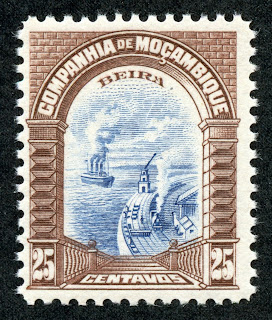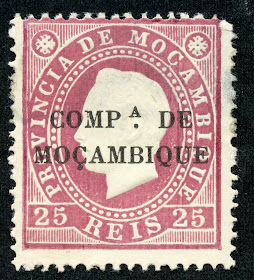1918 Scott 108 1/4c brown & yellow green
"Native and Village"
Quick HistoryThe reality is the Mozambique Company did little to develop the (present) provinces of Manica and Sofala. But, through using forced labor (Chibalo system) for the plantations, and the right to tax, they persisted for the 50 year concession lease from 1891-1941. Rebellions occurred in 1902 and 1917, mainly because of resistance to forced labor, and required interventions by the Portuguese.
Manica and Sofala provinces,
Northern section of Gaza and Inhamban:
Former Mozambique Company lands
But the Mozambique Company did produce unusually nice stamps for a Portuguese colony. And that is where they left their mark for WW classical collectors. Mainly two issues, the 1918-31 37 stamp issue, and the 1937 19 stamp issue, are wonderful bi-color pictorials engraved in London, and available today for little financial outlay.
1918 Scott 115 2 1/2c lilac & black
"Buzi River Scene"
Into the Deep BlueAs we already covered the Mozambique Company in a general way in the preceding blog post, we are free to concentrate on the Pictorials of 1918-31 and 1937.
2018 Update: Reader Dave Humphreys has this comment (and offer!) about the MC Pictorials -
"For Mozambique Company, I found that there were quite extensive perforation varieties listed in Gibbons. I was able to add varieties to the first 9 pages for that country, plus some postage dues.
Scott has since added the Ceres perforation varieties for the Portuguese Colonies. The Company issues are still listed as one, as far as I know. It made sense for me to break them down, especially the first long pictorial issue, as the perforation changes were often accompanied by colour/shade changes."
So Dave has modified album pages to reflect the various perforations found for the MC pictorials. If the reader would like to obtain his modified pages (in PDF) for the MC pictorials, send him a request via email.
dhum.mail
...and now some words to confuse email bots..
@gmail.com
Because of copyright concerns, Dave requests that the reader have already bought a Stamp Albums Web (Steiner) CD and/or is a Stamp Albums Web (Steiner) subscription holder.
Thanks Dave!
A closer look at the stamps and issues
My commentary for these issues will, at times, range beyond the stamp pictorial itself to how the pictorial subject is connected to the Mozambique of today.
1918 Scott 110 1/2c black "Man and Ivory Tusks"
Beautiful stamp. Horrible subject. Even today, poaching is only a misdemeanor, and Mozambique, (along with Laos and Vietnam), do the least to control trading in animal parts. In 2011, a survey of the Niassa National Reserve found 2,667 elephant carcasses.
1918 Scott 112 1 1/2c black & green
"Tapping Rubber Tree"
Mozambique is still interested in planting rubber trees for economic development.
Tapping a Rubber tree
A recent picture of Rubber tree tapping in Mozambique is shown here.
1918 Scott 113 2c carmine & black
"Sugar Refinery"
The sugar industry in Mozambique today employs 35,000 people, and accounts for 25% of the total agricultural exports.
1923 Scott 115 3c ocher & black "Corn"
Based on the pictorial image, the corn (maize) must be 12 feet high. ;-)
1921 Scott 117 4c green & brown "Tobacco Field"
The cultivation of tobacco is still ongoing in Mozambique. In fact, a recent concern is the replacement by farmers of food crops for tobacco crops.
1925 Scott 122 6c lilac & black
"Coffee Plantation"
Living in the Pacific Northwest, I am partial to good coffee. ;-) Although there may be some coffee beans grown in Mozambique, my internet research only yielded the use of instant coffee with the addition of some chicory.
1923 Scott 123 7c ultramarine & black
"Scene on Beira Railroad"
The Beira Railroad established a link to Salisbury (Harare) in Southern Rhodesia (now Zimbabwe) in 1899.
Steam Engine- Beira Railway
Here is a pic of the Class F2 two foot rail gauge steam locomotive of the Beira railway.
1918 Scott 124 7 1/2c orange & green
"Orange Tree"
The 1918-31 thirty-seven stamp issue was engraved/produced in London. I'm not sure which printing firm- although the 1937 set was produced by Waterlow & Sons.
1923 Scott 128 12c brown & black"Cotton Field"
About 8% of the world's cotton is produced in Sub-Saharan Africa. Most of it is grown by smallholder farmers. One can help by buying "Cotton made in Africa"- An Aid by Trade Foundation Initiative.
1918 Scott 132 30c red brown & black
"Coconut Palm"
Copra is the dried meat of the coconut. Coconut oil is extracted from it, and the remaining coconut-oil cake is mostly used for livestock feed.
1925 Scott 136 40c greenish blue & black "Mangroves"
Mangrove swamps are found in the deltas of the Zambezi river.
1918 Scott 137 50c orange & black "Cattle"
Today there is about 1.2 million head of cattle in Mozambique. The northern provinces, though, are affected by the tsetse fly.
1925 Scott 141 80c carmine & black
"Sisal Plantation"
One can find Sisal fiber rugs from Mozambique with a little internet sleuthing.
Mozambique Sisal Fiber Rugs
Sisal is a a type of agave plant that yields a fiber that is used in making twine and rope.
1925 Scott 143 1e blue & black
"Company Arms"
The last pictorial that I will show for the 1918-31 issue has the Mozambique Company "Arms". The issue must have been readily available to the dealer trade, as all stamps are CV <$1.
1937 Scott 175 1c yellow green & violet "Giraffe"
An agreement to transfer some Giraffes from Kruger National Park in South Africa to just across the border into Limpopo National Park in Mozambique is helping to repopulate a wildlife area decimated by civil wars and poaching.
1937 Scott 176 5c blue & yellow green
"Thatched huts"
A scene still found in Mozambique.
1937 Scott 177 10c vermilion & ultramarine "Dhow"
A Dhow (Arabic derivation) is a vessel with lateen sails, and could be found in the Indian Ocean, and down the coast of East Africa.
1937 Scott 178 15c carmine & black
"St. Caetano Fortress, Sofala"
The Fortress was built in 1505 by the Portuguese on the Sofala Bank in the (now) Province of Sofala in Mozambique.
The Sofala Fortress in 1666
The stones were imported from Europe, and were subsequently used to build the Beira Cathedral.
1937 Scott 179 20c green & ultramarine "Zebra"
The Plains zebra is found throughout East Africa in game reserves. What a beautiful stamp!
1937 Scott 182 45c blue & brown "Lion"
It is estimated that there are about 800-1,000 lions within the boundaries of the Niassa National Reserve.
1937 Scott 184 60c carmine & blue "Leopard"
About 50% of the Mozambique land area is suitable for leopard habitat. It is thought there is perhaps about 20,000 leopards in Mozambique.
1937 Scott 185 70c yellow brown & pale green
"Mozambique woman"
Most natives are of Bantu origin, and a number (>10!) of Bantu languages are spoken. (Portuguese is the official language, but only 40% of the population is fluent.)
1937 Scott 186 80c carmine & pale green
"Hippopotami"
The rivers, specifically the Zambezi, have hippopotamus.
Distribution of the Hippopotamus in Africa
There are perhaps about 16,000 in Mozambique.
Deep Blue
1918-31 Views of Mozambique issue in Deep Blue
The pictorials in this blog are found spread over four pages in Deep Blue (Steiner).
925 Scott 145 2e lilac & black
"View of Beira"
Big BlueTwenty-nine of the thirty-seven stamps of the 1918-31 issue, and twelve of the nineteen stamps of the 1937 Pictorial issue are found in BB. I suppose I should feel grateful. ;-)
1937 Scott 188 1e deep blue & black
"Man in canoe"
Out of the BlueReviewing the classic pictorials of Mozambique Company- what fun!
Note: Map, and pics appear to be in the public domain.
Comment?
























.jpg)










.jpg)




























